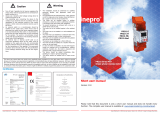
Crestron STX-1700C 2-Way RF Wireless Touchpanel
Battery Status
BATTERY STATUS
To access the Battery Status screen, shown to the left, press the Battery Status
button on the SETUP MENU.
This screen indicates the amount of charge (or life) remaining in the battery as a
percentage of full capacity, if the battery is installed. An analog bar is provided
below the percentage amount as a quick visual reference to the approximate level of
charge remaining. The EXTERNAL POWER label appears if external power is
applied either through the docking station or via the optional power pack. Note that
battery recharging takes place only through the docking station. Touch the Return
button to display the SETUP MENU.
NOTE: When charging the battery, the battery status screen is not an accurate
indicator of battery level. The battery status screen will indicate a full charge (100%)
before the docking station indicates that charging is complete (RDY illuminates).
Select Interface
SELECT INTERFACE
The touchpanel communicates with a control system to activate commands or to
display feedback from components within the system. The communication interface
must be correctly specified or communication will not occur. To set communication
parameters, first select the Interface button on the SETUP MENU to display the
SELECT INTERFACE screen, shown to the left. Then, select either the CRESNET
or the RF button to display the CRESNET INTERFACE MENU or the RF SETUP
screen, respectively. Use these screens to set the Cresnet network identity
(CRESNET ID) and the RF ID numbers.
Cresnet Interface Menu
CRESNET INTERFACE MENU
03
RF SETUP
1
CRESNET ID is a two-digit hexadecimal number that can range from 03 to FE. Note
that this number and the Net ID set in the SIMPL Windows program of the Cresnet
system must match when operating as a wired touchpanel and for file transfers. Net
ID for the STX-1700C is factory set to 03.
The UP and DOWN buttons increase and decrease the CRESNET ID by one digit
(i.e., 03, 04, 05, . . .FE).
Select the Return button to return to the SELECT INTERFACE screen.
RF Setup
The radio frequency identity number (RF ID) is necessary to secure RF
communications such that controls can be activated from the touchpanel. The RF ID
consists of a one-digit hexadecimal number. The touchpanel can be set to one of
fifteen numbers; “1” is shown as an example in the illustration and is the default.
The RF ID setting should match the value assigned to the STX-1700C touchpanel
definition in the SIMPL Windows program. Refer to “C2Net-Device Slot in
Configuration Manager” on page 14 for information about SIMPL
programming/setup for this touchpanel.
The UP and DOWN buttons increase and decrease the RF ID most significant digit
by one, respectively (i.e., 1, 2, 3, …F).
The radio frequency channel setting (RF Channel) is necessary for two-way
communication between the touchpanel and the STRFGWX. The RF channel
consists of a one-digit hexadecimal number. “0” is shown as an example in the
illustration on the left and is the default. The down an up arrow buttons increase and
Operations Guide - DOC. 6226A 2-Way RF Wireless Touchpanel: STX-1700C • 9























